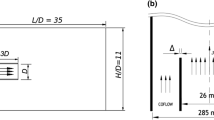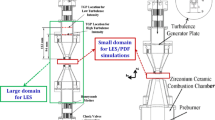Abstract
The turbulence modeling in probability density function (PDF) methods is studied through applications to turbulent swirling and nonswirling co-axial jets and to the temporal shear layer. The PDF models are formulated at the level of either the joint PDF of velocity and turbulent frequency or the joint PDF of velocity, wave vector, and turbulent frequency. The methodology of wave vector models (WVMs) is based on an exact representation of rapidly distorted homogeneous turbulence, and several models are constructed in a previous paper [1]. A revision to a previously presented conditional-mean turbulent frequency model [2] is constructed to improve the numerical implementation of the model for inhomogeneous turbulent flows. A pressure transport model is also implemented in conjunction with several velocity models. The complete model yields good comparisons with available experimental data for a low swirl case. The individual models are also assessed in terms of their significance to an accurate solution of the co-axial jets, and a comparison is made to a similar assessment for the temporal shear layer. The crucial factor in determining the quality of the co-axial jet simulations is demonstrated to be the proper specification of a parameter ratio in the modeled source of turbulent frequency. The parameter specification is also shown to be significant in the temporal shear layer.
Similar content being viewed by others
References
Van Slooten, P.R. and Pope, S.B., PDF modeling for inhomogeneous turbulence with exact representation of rapid distortions. Phys. Fluids 9(4) (1997) 1085.
Van Slooten, P.R., Jayesh and Pope, S.B., Advances in PDF modeling for inhomogeneous turbulent flows. Phys. Fluids 10(1) (1998) 246.
Pope, S.B., PDF methods for turbulent reactive flows. Prog. Energy Combust. Sci. 11 (1985) 119.
Pope, S.B., Langrangian PDF methods for turbulent flows. Ann. Rev. Fluid Mech. 26 (1994) 23.
Pope, S.B., A Lagrangian two-time probability density function equation for inhomogeneous turbulent flows. Phys. Fluids 26 (1983) 3448.
Haworth, D.C. and Pope, S.B., A generalized Langevin model for turbulent flows. Phys. Fluids 29(2) (1986) 387.
Pope, S.B., On the relationship between stochastic Lagrangian models of turbulence and second-moment closures. Phys. Fluids 6(2) (1994) 973.
Wouters, H.A., Peeters, T.W.J. and Roekaerts, D., On the existence of a stochastic Lagrangian model representation for second-moment closures. Phys. Fluids 8(7) (1996) 1702.
Haworth, D.C. and Pope, S.B., A pdf modeling study of self-similar turbulent free shear flows. Phys. Fluids 30(4) (1987) 1026.
Anand, M.S., Pope, S.B. and Mongia, H.C., PDF calculations for swirling flows. AIAA Paper No. 93-0106 (1993).
Anand, M.S., Takahashi, F., Vangsness, M.D., Durbin, M.D. and Schmoll, W.J., An experimental and computational study of swirling hydrogen jet diffusion flames. J. Engrg. Gas Turbine and Power (1997) 119. Also, ASME Paper No. 95-GT-307 (1995)
Anand, M.S., Hsu, A.T. and Pope, S.B., Calculations of swirl combustors using joint velocity-scalar probability density function method. AIAA J. 35(6) (1997) 1143.
Fu, S. and Pope, S.B., Computation of recirculating swirling flow with the GLM Reynolds stress closure. Acta Mech. Sinica 10 (1994) 110.
Norris, A.T. and Pope, S.B., Modeling of extinction in turbulent flames by the velocity-dissipation-composition PDF method. Combust. Flame 100 (1995) 211.
Minier, J.P. and Pozorski, J., Analysis of a PDF model in a mixing layer case. In: Tenth Symposium on Turbulent Shear Flows (1995) p. 26.
Masri, A.R., Subramaniam, S. and Pope, S.B., A mixing model to improve PDF simulation of turbulent diffusion flames. In: Twenty-Sixth Symposium (International) on Combustion (1996) p. 49.
Delarue, B. and Pope, S.B., Calculations of subsonic and supersonic turbulent reacting mixing layers using probability density function methods. Phys. Fluids 10(2) (1998) 487.
Dreeben, T.D. and Pope, S.B., PDF/Monte Carlo simulation of near-wall turbulent flows. J. Fluid Mech. 357 (1998) 141.
Launder, B.E. and Morse, A.P., Numerical prediction of axisymmetric free shear flows with a Reynolds stress closure. In: Turbulent Shear Flows 1. Springer-Verlag, Berlin (1979) p. 279.
Jones, W.P. and Pascau, A., Calculation of confined swirling flows with a second moment closure. J. Fluids Engrg. 111 (1989) 248.
Ohtsuka, M., Numerical analysis of swirling non-reacting and reacting flows by the Reynolds stress differential method. Internat. J. Heat Fluid Flow 38(2) (1995) 331.
Kassinos, S.C. and Reynolds, W.C., A structure-based model for the rapid distortion of homogeneous turbulence. Technical Report TF-61, Stanford University (1994).
Rogers, M.M. and Moser, R.D., Direct simulation of a self-similar turbulent mixing layer. Phys. Fluids 6(2) (1994) 903.
Lumley, J.L., Computational modeling of turbulent flows. In: Advances in Applied Mechanics, Vol. 18, Academic Press (1978) p. 123.
Pope, S.B. and Chen, Y.L., The velocity-dissipation probability density function model for turbulent flows. Phys. Fluids A 2(8) (1990) 1437.
Pope, S.B., Application of the velocity-dissipation probability density function model to inhomogeneous turbulent flows. Phys. Fluids A 3(8) (1991) 1947.
Jayesh and Pope, S.B., Stochastic model for turbulent frequency. Technical Report FDA 95-05, Cornell University (1995)
Delarue, B. and Pope, S.B., Application of PDF methods to compressible turbulent flows. Phys. Fluids 9(9) (1997) 2704.
Xu, J. and Pope, S.B., Sources of bias in particle-mesh methods for PDF models for turbulent flows. Technical Report FDA 97-01, Cornell University (1997).
Takahashi, F. and Vangsness, M.D., Measurements in swirling and non-swirling coaxial turbulent air jets — No. 1: No swirl, 100 m/s. Technical Report UDR-TR-91-160, University of Dayton, Ohio (1991).
Takahashi, F., Vangsness, M.D. and Belovich, V.M., Measurements in swirling and non-swirling coaxial turbulent air jets — No. 3: 30-degree swirl, 100 m/s. Technical Report UDR-TR-91-162, University of Dayton, Ohio (1991).
Bell, J.H. and Mehta, R.D., Development of a two-stream mixing layer from tripped and untripped boundary layers. AIAA J. 28(12) (1990) 2034.
Pope, S.B., PDF2DV: A FORTRAN code for solving modeled joint-PDF equations in two-dimensions. Cornell University (1994).
Dreeben, T.D. and Pope, S.B., Nonparametric estimation of mean fields with application to particle methods for turbulent flows. Technical Report FDA 92-13, Cornell University (1992).
Pope, S.B., Position, velocity and pressure correction algorithm for particle method solution of the PDF transport equations. Technical Report FDA 95-06, Cornell University (1995).
Naot, D., Shavit, A. and Wolfshtein, M., Interactions between components of the turbulent velocity correlation tensor. Israel J. Tech. 8 (1970) 259.
Launder, B.E., Reece, G.J. and Rodi, W., Progress in the development of a Reynolds-stress turbulence closure. J. Fluid Mech. 68(3) (1975) 537.
Shih, T.H. and Lumley, J.L., Modeling of pressure correlation terms in Reynolds stress and scalar flux equations. Technical Report FDA 85-3, Cornell University (1985).
Fu, S., Launder, B.E. and Tselepidakis, D.P., Accommodating the effects of high strain rates in modelling the pressure-strain correlation. Technical Report TFD/87/5 and TDF/89/1, UMIST (1987).
Speziale, C.G., Sarkar, S. and Gatski, T.B., Modelling the pressure-strain correlation of turbulence: An invariant dynamical systems approach. J. Fluid Mech. 227 (1991) 245.
Johansson, A.V. and Hällback, M., Modelling of rapid pressure-strain in Reynolds-stress closures. J. Fluid Mech. 269 (1994) 143.
Ristorcelli, J.R., Lumley, J.L. and Abid, R., A rapid-pressure covariance representation consistent with the Taylor-Proudman theorem materially indifferent in the two-dimensional limit. J. Fluid Mech. 292 (1995) 111.
Yeung, P.K. and Pope, S.B., Lagrangian statistics from direct numerical simulations of isotropic turbulence. J. Fluid Mech. 207 (1989) 531.
Hanjalić, K. and Launder, B.E., A Reynolds stress model of turbulence and its applications. J. Fluid Mech. 52 (1972) 609.
Dimotakis, P.E., Turbulent free shear layer mixing and combustion. In: Murthy, S.N.B. and Curran, E.T. (eds), High-Speed-Flight Propulsion Systems, AIAA, Washington, DC (1991) p. 265.
Author information
Authors and Affiliations
Rights and permissions
About this article
Cite this article
Van Slooten, P., Pope, S. Application of PDF Modeling to Swirling and Nonswirling Turbulent Jets. Flow, Turbulence and Combustion 62, 295–334 (1999). https://doi.org/10.1023/A:1009993003851
Issue Date:
DOI: https://doi.org/10.1023/A:1009993003851




